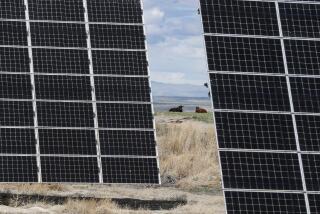Winds of Change Are Energizing European Industry
- Share via
HERNING, Denmark — Windmills are becoming a serious alternative to coal and oil in Europe, scientists say.
The amount of electricity generated by high-technology windmills will grow 30 times in Western Europe by the year 2005 as the infant windmill sector grows, said speakers at the European Community Wind Energy Conference in Denmark this month.
Dr. Wolfgang Palz, chairman of the conference and head of the EC Commission’s Renewable Energies Division, said: “The European wind energy sector has managed to cut its production costs by one-third in recent years and further cuts are possible, giving rise to optimism that wind will soon be fully competitive with coal.”
Modern windmills come in all shapes and sizes, and the most efficiently designed can convert up to half of the wind’s power into electricity.
Untapped Potential
There are many types of blades. Most turbines are shaped in the traditional cross-form, but a new mill in Canada looks like an egg-beater.
EC specialists are drawing up the first comprehensive European Wind Atlas, due for publication this year.
They have already found that Europe’s strongest winds blow on the north coast of Scotland and the nearby Orkney Islands, while the lowest are in Italy, sheltered by the Alps.
At present the 12 member states of the EC consume 200,000 megawatts of energy a year, with wind energy contributing a meager 100 megawatts.
But scientists say that northern Europe and Greece have massive untapped wind potential and they predict that in 20 years’ time the Community will produce an annual 3,000 megawatts from wind, enough to fuel three million households.
Taken More Seriously
Palz said at the five-day conference in Herning, in western Denmark, that the outlook is for rising coal prices and stable oil prices, which would make wind energy more viable.
“Production costs will drop a further third within the coming five years due to improved cost-effectiveness, and the durability of new windmills is now up to 25 years,” Palz added.
“With a firmer domestic base, European windmill manufacturers will be better able to export to the vast U.S. market and open new markets in high-wind countries in the Third World such as India, China and the Arab states.
“The EC Commission is not anti-nuclear in energy matters, but environmental factors and low labor requirements speak heavily in favor of wind energy,” he said. “Windpower (the modern industry) started off only a decade ago as an idealistic, environmentalist campaign with no commercial reality. Today we are taking windpower seriously.”
Denmark Leads Industry
An electricity-generating windmill costs about $1,000 a kilowatt to build and install, so a typical 300-kilowatt mill will cost $300,000.
Windmills producing 300 to 700 kilowatts are already almost as cost-effective as conventional coal fired electricity plants, according to EC estimates.
More to Read
Sign up for Essential California
The most important California stories and recommendations in your inbox every morning.
You may occasionally receive promotional content from the Los Angeles Times.













